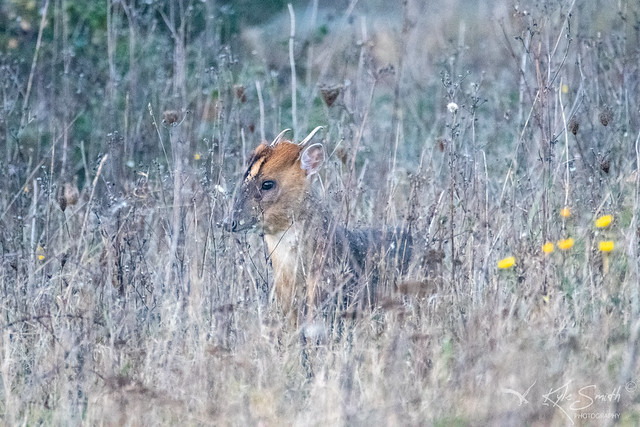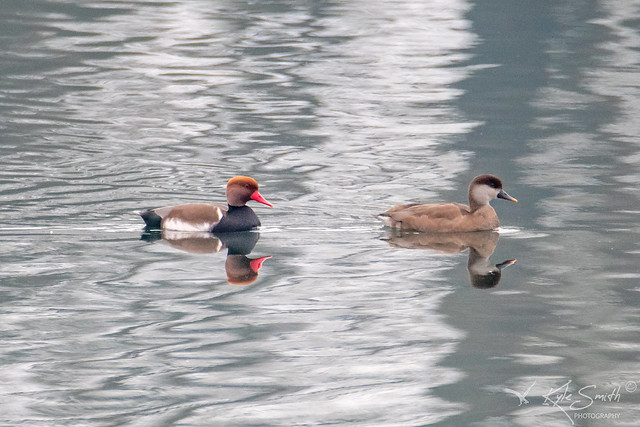What a beautiful morning it turned out to be - bacon sandwich and coffee to get me going and then a walk with Charlotte at the Pauline Flick Reserve, managed by the Banbury Ornothological Society (BOS). To be precise it is managed by Jan Guilbride and as we pulled off the road we found her unloading feed and compost from the boot of her car into a wheelbarrow. I'd listened to her giving a presentation on a monthly Zoom Meeting for the BOS members during lockdown and knew who she was straight away. We chatted and she realised who I was from the sightings and blog post from my previous/first visit.
Charlotte offered our help with the wheelbarrow but Jan opted to stick to her plan.
We started on ahead and walked through the trees looking increasingly autumnal. I'd mentioned some flyover fieldfare on my last visit but now we could hear and see at least 24 individuals - we also counted 4 redwing on the same berries. No doubt why these winter thrushes were here - the abundance of berry-laden bushes was evident.
We saw the usual blue and great tits at the feeders but also coal and long-tailed on or nearby. Dunnock, chaffinch and robin fedd too. A red kite quartered the hedgerow but soon drifted away.
We reached the area where Jan has erected a barrier to limit disturbance of a tawny owl roost and we could see where that was ahead. Jan also mentioned nesting jays in the spring but there is little evidence of a food source along this stretch so likely across the Chipping Norton - Stratford Road.
I showed Charlotte the exposed layered limestone before turning back. In the tops of the trees and bushes opposite there were branches laden with berries. A single bird cut through, stopping briefly on a stalk to the back. We could see a colour and initially had it down as a chaffinch but as we moved round we could see it was actually a male bullfinch - made Charlotte's day.
We passed Jan near the feeders and chatted briefly before making our way back to the car. On the way we had more views of winter thrushes feeding and watering by the stream in the valley below, and female bullfinch feeding on treetop mast.
On the return to Banbury we saw great spotted woodpecker over the fields. All in all a very pleasant morning.
After lunch I thought I'd pop up to Balscote Quarry to see if I could connect with brambling or the merlin being reported intermitantly. There were very large flocks of winter thrushes, mostly fieldfare and totalling c.100. There were also small flocks of redwing that passed over, c.6 each time. A great spotted woodpecker passed over twice and the kestrel hunted for a short time before landing on the sand martin pill where it stayed for more than 30 minutes.
As the light left a pair of muntjac deer passed, the female bounding through and the male deciding to turn back.
Two mute swan dropped in to join two thers already in residence. They swam but then comically stood up as the water was still relatively shallow. They then had a second thought and left, stage left.
The sun dropped and a late jay passed the viewpoint giving no opportunity to raise a camera in time and not enough light to do much with it if I had. The sunset was one to be enjoyed.
As a opened the boot of the car a small flock of 9 long-tailed tits made for their roost and pipistrelle bats passed overhead.
An early alert went out of a pair of red-crested pochard at Grimsbury Reservoir - a rare visitor there. I swethered whether to go but when an update came that they were still there after 30 minutes I got dressed and went. They stayed distant but were graceful enough to put on a show of gently cruising back and forth for a good while.
Eventually the female decided to have a kip and that was when I decided to pull stumps. Kevin Heath of recent brambling fame joined and the finder John passed by. Another regular Mike P also came for a look and while we socially distanced for a quick chat a pochard passed overhead but didn't stop.
I returned to Balscote Quarry and counted 74 black-headed gulls, 11 lapwing, 9 fieldfare, fa pair of song thrushes, locks of mixed yellowhammer and reed bunting, and both great spotted and green woodpecker. Despite Steve Holliday having scattered seed under the feeders, the brambling never showed - the various finches did grow in numbers but not with their new friend. A single goldcrest passed behind and a pair of stonechats were initially distant but closed the distance enough for some shots before the weather drew in.
I packed up and as I turned to go a muntjac slipped back out of view into the bushes.










No comments:
Post a Comment